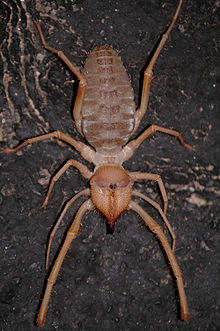Solifugae
| Solifugae Temporal range: Late Carboniferous–recent |
|
|---|---|
 |
|
| Solifugid from Arizona | |
| Scientific classification | |
| Kingdom: | Animalia |
| Phylum: | Arthropoda |
| Subphylum: | Chelicerata |
| Class: | Arachnida |
| Order: |
Solifugae Sundevall, 1833 |
| Families | |
Solifugae is an order of animals in the class Arachnida known variously as camel spiders, wind scorpions, sun spiders, or solifuges. The order includes more than 1,000 described species in about 153 genera. Despite the common names, they are neither true scorpions (order Scorpiones) nor true spiders (order Araneae) – though they are more closely related to scorpions than to spiders. Much like a spider, the body of a solifugid has two tagmata: an opisthosoma (abdomen) behind the prosoma (that is, in effect, a combined head and thorax). At the front end, the prosoma bears two chelicerae that, in most species, are conspicuously large. The chelicerae serve as jaws and in many species also are used for stridulation. Unlike scorpions, solifugids do not have a third tagma that forms a "tail". Most species of Solifugae live in dry climates and feed opportunistically on ground-dwelling arthropods and other small animals. The largest species grow to a length of 12–15 cm (5–6 in), including legs. A number of urban legends exaggerate the size and speed of the Solifugae, and their potential danger to humans, which is negligible.
Solifugae are moderately small to large arachnids (a few millimeters to several centimeters in body length), with the larger species reaching 12–15 cm (5–6 in) in length, including legs. In practice, the respective lengths of the legs of various species differ drastically, so the resulting figures are often misleading. More practical measurements refer primarily to the body length, quoting leg lengths separately, if at all. The body length is up to 7 cm (3 in). Most species are closer to 5 cm (2 in) long, and some small species are under 1 cm (0.4 in) in head-plus-body length when mature.
Like that of the spider order, the Araneae, the body plan of the Solifugae has two main tagmata: the prosoma, or cephalothorax, is the anterior tagma, and the 10-segmented abdomen, or opisthosoma, is the posterior tagma. As shown in the illustrations, the solifugid prosoma and opisthosoma are not separated by nearly as clear a constriction and connecting tube or "pedicel" as occurs in "true spiders", the order Araneae. The lack of the pedicel reflects another difference between Solifugae and spiders, namely that Solifugids lack both spinnerets and silk, and do not spin webs. Spiders need considerable mobility of their abdomens in their spinning activities, and the Solifugae have no need for any such adaptation.
...
Wikipedia
